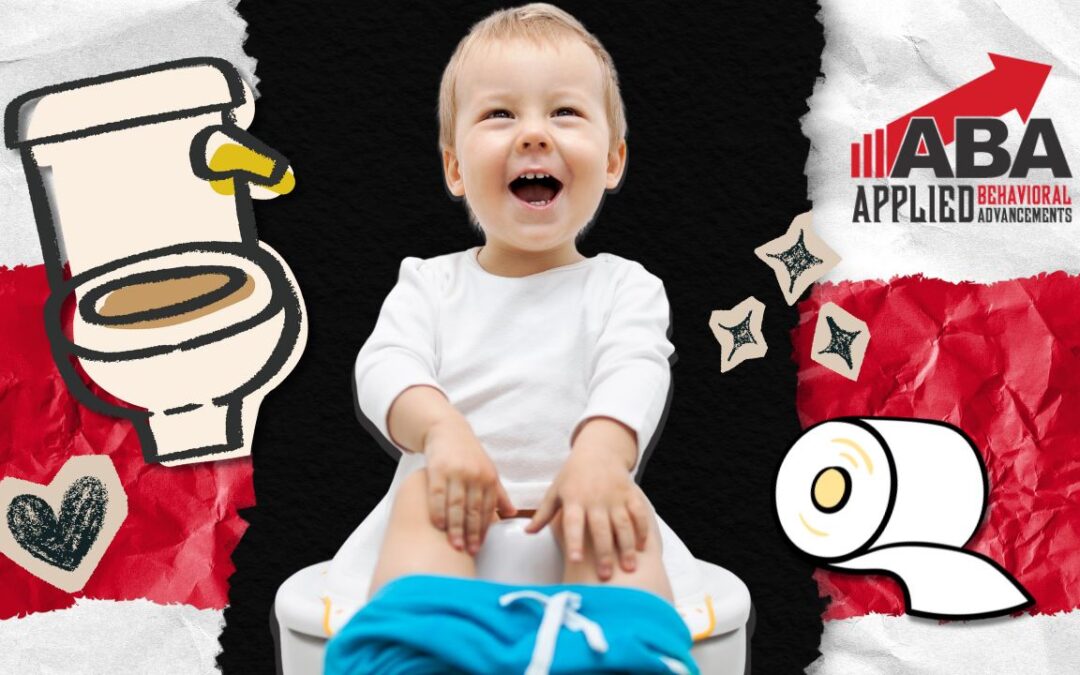Every parent knows that potty training can be a challenging part of raising toddlers. But did you know you can use the data-backed science of Applied Behavior Analysis (ABA) to make potty training a breeze? In this episode of ABA-LLC’s Parent Training Series, TLBA Kyle Strunk walks you through setting up a program to help increase your child’s use of the toilet.
The advice about using ABA for potty training builds on what we’ve been learning throughout our Parent Training Series. Past topics have included the Function of behavior, prevention strategies, and reinforcement. We are always open to feedback from our audience about what they would like to learn next! Click here to view the whole series.
Using ABA For Potty Training
What do I do when my child does not communicate or show signs of needing to go to the bathroom?
- Identify a method to communicate the need to use the bathroom and get EVERYONE in the house to do it. Seeing the whole family doing this behavior will encourage your child to replicate this behavior.
- Try developing a social story that you read to your child several times a day. The story should include the method identified to communicate need to use the restroom. Have different family members take turns reading the story and modeling it to the child.
My child will not go to the bathroom when asked.
- Try making the bathroom fun! Set up a playtime in the bathroom. Sit with the toilet closed and the child on your lap and read a story or play a game.
- Reinforce your child just for going to the bathroom! You can start by reinforcing just when they get to the door, then further in and further in, shaping the duration and where in the bathroom they go once inside.
What if my child won’t stay sitting on the toilet?
- Reinforce the duration of sitting on the toilet. Use a timer to help your child know how long they need to sit.
- Do not ‘force’ the child to sit on the toilet, but rather find ways to make it fun so they will want to stay there. Try singing some fun “toilet” songs, something like the songs on Bruce Lansky’s album “Tinkle, Tinkle, Little Tot”
What to do when they won’t eliminate once on the toilet
- Once your child has mastered sitting and staying on the toilet, fade reinforcement. The new criteria for receiving reinforcement will be eliminating.
- If the child is sitting and not eliminating, have them sit for around a max of 10 minutes, then offer them a break of 5-10 minutes. Then, send them back to sitting. This is helpful because often children have accidents immediately after getting up off the toilet.
- Most children will learn to urinate more quickly than defecating. To counter this, you will need to fade reinforcement for urinating and increase the reinforcement for defecating. (i.e., 1 M&M for urinating, the whole bag for defecating).
More tips and Tricks
- Modeling is extremely helpful for helping children learn to use the toilet. Make a big deal about how everyone in the family does the same thing. Often, we are so private about using the restroom that the child has no idea that everyone else in the family is using the restroom multiple times a day.
- No matter the sex of your child, it is typically easier and less messy to first learn to sit on the toilet.
- If the child has an accident, minimize attention when changing them, then immediately go back through the social story about using the toilet. The goal is not to punish them, but to avoid giving them more reinforcement for having an accident than for following the steps in the bathroom social story you created.
About ABA-LLC
ABA-LLC is one of the largest suppliers of Behavior Support in the State of Kentucky. Since 2007, the agency has created innovative strategies to improve the lives of unique individuals. ABA-LLC contracts with around 160 contractors, each dedicated to building an inclusive culture that celebrates individuals of all abilities. No matter who you are, you can reach your goals at ABA-LLC. In everything the agency does, ABA-LLC is set apart from its competitors by its uniquely person-centered approach. The agency strives to provide services from a place of deep love for the population they serve. Their work exemplifies the belief that every individual has a right to live a fulfilling and independent life integrated within their communities. There is no objective to change a person, but rather to give them the tools they need to succeed. B.F. Skinner summarizes this vision in his quote: “I’m not trying to change people. All I want is to change the world in which they live.”

